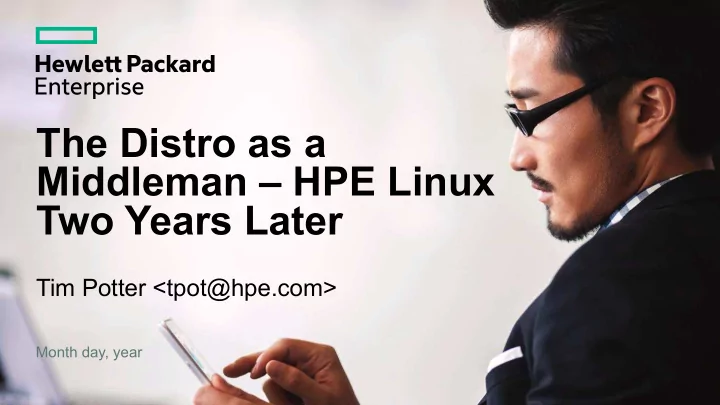

The Distro as a Middleman – HPE Linux Two Years Later Tim Potter <tpot@hpe.com> Month day, year
Overview Part 1 – What is HPE Linux? Part 2 – What we did and lessons learned Part 3 – Exploring the idea of distro as a middleman 2
What is HPE Linux? 3
What is HPE Linux? (2015) – Internal Linux distribution based on Debian Jessie – Was called hLinux pre HPI/HPE split – One (internal) customer, HP Helion, https://www.hpe.com/helion – “Foreign packages” concept used to manage non-Jessie software – Modified for specific needs – Not found in Debian – The goal is to get into Debian wherever possible – Kernel – 3.14 and 4.1 longterm kernels – Driver enhancements with external partners 4
What is HPE Linux? (2016) – Internal Linux distribution based on Debian Jessie – Now a HPE Technology Standard – Many customers in various stages of product development – “Foreign packages” concept used to manage non-Jessie software – Some vendor packages replaced by Debian main versions – Jessie backports now used for some foreign packages – Still keen on minimising the diff between HPE Linux and Jessie – Kernel – 4.4 kernel – Driver enhancements with external partners 5
HPE Linux is now a HPE Technology Standard – HPE Linux is now one of three global technology standards within the company – Announced in December 2015 by CTO Martin Fink – A shared Linux distribution across the company for embedded use (not a desktop) – A TS allows intra-company innovation and economies of scale – What does this mean? – More investment in Debian – More Debian developers and users (engineers and customers) – More commercial products powered by Debian – Some products/customers/markets may require a non-HPE Linux solution – Bummer 6
What we did and lessons learnt • Product achievements • Community achievements • Process achievements 7
Product Achievements – More successful releases of HPE Helion based on HPE Linux – HPE Helion OpenStack 2.0, 2.1 and 3.0 – Many new products under development using HPE Linux – Lots of interest in Docker and Kubernetes as a development and distribution framework – HPE Linux as a Technology Standard in the company – Lessons – Treat your reference customers very well! – Delivering enterprise software on Debian is definitely possible – Not too much push-back switching OS’s if it Just Works – Centralization is essential 8
Community Achievements – Assisted in packaging Elasticsearch for Debian – Free replacement for vendor packaging – Assisted in packaging Docker 1.11.0 for Debian – Free replacement for vendor packaging – Contributions to uEFI Secure Boot – Shipping Secure Boot to customers in kernel 4.4 – Several full rebuilds of arm64 archive by tbm – Lessons – Working with the community takes a lot of time – Hard work getting people to start packaging and becoming DM/DD 9
Process Improvements – Success has not lead to many more resources, only more work – Constantly need to do more with less – Implementation of “Baseline Release” process – Package acceptance tests – Security analysis tools – Fledgling CI/CD system for bare-metal and VM testing – Lessons – Technology is easy, getting human processes working is hard – Process improvement is continuous and never ending 10
Distro as a middleman • What is a middleman? • Examples of middlemen 11
What is a Middleman? – A middleman sits in between two parties in a transaction – A middleman provides value to buyers and sellers – Middlemen aren’t necessarily bad – Middlemen are OK if they add more value then they take 12
Examples of middlemen 13
Examples of middlemen 14
Examples of middlemen 15
Examples of middlemen 16
Examples of middlemen 17
The Debian distro as a middleman – Who are the parties involved? – Users – Software – Debian Developers – Upstream developers – What value does Debian add for each party above? – Users: get access to a lot of software – Software: get access to many users – DDs: community – Upstream: well-integrated environment, access to users 18
The HPE Linux distro as a middleman – What value does HPE Linux add inside HPE? – Centralised point for communications – Bears risk for technical and legal issues – Sharing large costs (and benefits!) amongst all users – Enforce standards – Insulate users from having to make hard/unpopular decisions or requests 19
What value does Debian add to $YOUR_ORGANISATION? – What happens when – s/HPE Linux/Debian/ – s/HPE/$YOUR_ORGANISATION/ – How can you sell Debian in $YOUR_ORGANISATION with middleman analogy? – The middleman analogy is powerful and is useful for communicating the costs and benefits of Debian 20
The Middleman Economy – Ideas in this talk taken from “The Middleman Economy” , by Marina Krakovsky – Breaks down middlemen into six categories 1. The Bridge 2. The Certifier 3. The Enforcer 4. The Risk Bearer 5. The Concierge 6. The Insulator 21
Thank you Tim Potter <tpot@hpe.com> 22
Recommend
More recommend